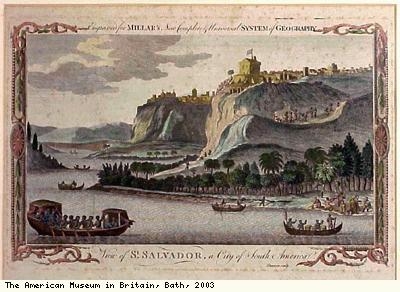Page 1 of 1 pages
View of St Salvador

Description:
Print of engraving: View of St Salvador, a City of South America.
Engraved from Millar’s New Complete and Universal System of Geography.
Hand coloured print showing slaves in the 18th century.
Salvador is the third largest city in Brazil and capital of the state of Bahia, South America.
It quickly became the main Brazilian sea port and first capital of Portuguese Brazil; a centre of the sugar industry and the slave trade. From 1500 to 1815, Salvador was Brazil’s busiest port. A significant portion of the sugar from the northeast and gold and diamonds from the mines in the southeast passed through Salvador.
It was a golden age for the town; magnificent homes and churches were built.
Salvador was built on two levels; the cidade alta (upper city); with the Cathedral and administrative buildings and the cidade baixa (lower city); with the forts, docks, and warehouses on the beaches.
It is still divided into upper and lower cities, with a population of 2,250,000 inhabitants. Most of these people are descended from the mixture between black, white and Amerindians.
In Salvador, the African influence in the makeup of Brazilian culture is readily visible. There are dishes called by their African names (caruru, vatapa, acaraji ). There are ceremonies of candombli ; which honour both African deities (gods or goddesses) and Catholic holidays. Capoeira schools exist, where a unique African form of ritualistic fighting is taught.
The main religions in Salvador are Catholicism, Candomble, Protestantism, Espiritism, and most recently Mormons.
It is common for some people to take and believe in aspects from different religions; this probably started when slaves were not allowed to pray to their own gods. They took on surrogate gods to show their owners they were praying to catholic gods; they were actually praying to their own.
This has led to the fact that for almost any catholic saint, there is a corresponding deity; both honoured on the same day.
Contributed by John Judkyn Memorial.
Creator: Millar
Date: 18th century
Copyright: The American Museum in Britain, Bath
Object ID:72.01
Page 1 of 1 pages

